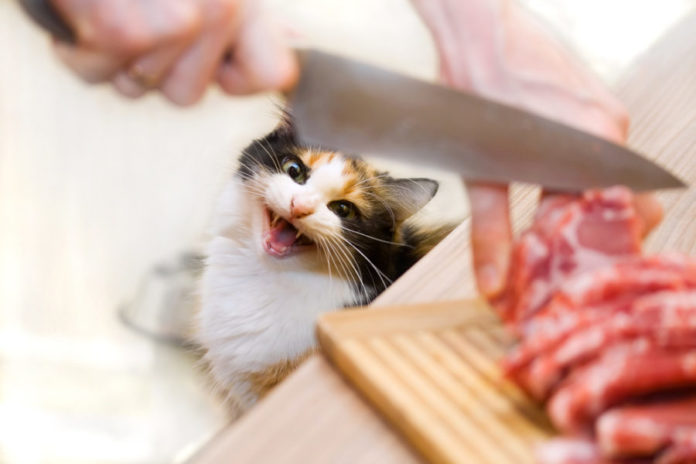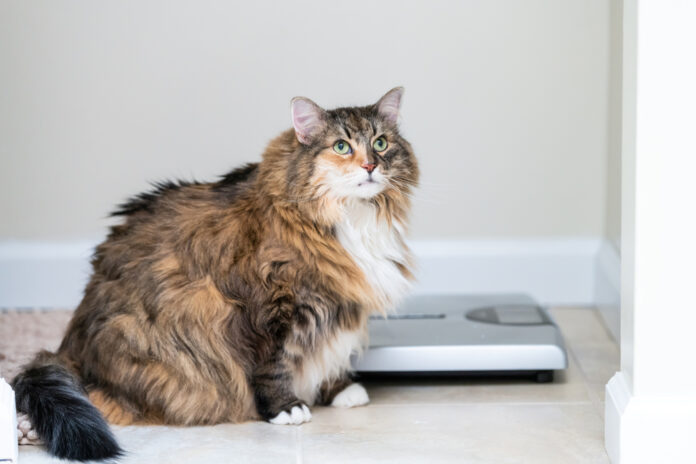Raw feeding your cat

Raw feeding is one of the healthiest choices you can make for your kitty. But here are two things you need to know before making the switch.
Have heard or read about the benefits of raw meat-based diets? Raw proponents believe because cats evolved eating whole, raw prey animals that modern cats should be fed in a similar way – or as close to it as we can get. But a lot of veterinarians, the FDA, and many others claim that raw feeding diets are dangerous, not only to your cat but to everyone in the household. What’s the right answer?
The popularity of raw feeding diets has increased exponentially in the last decade, especially after the melamine-contamination recall scandal in 2007, which sickened or killed tens of thousands of cats and dogs. But the debate between raw feeders and everyone else continues and focuses mainly on two areas: quality and safety. Let’s look at the reality, so you can draw your own conclusions.
Consider quality
Many raw feeding enthusiasts like to home prepare their cats’ food, pointing out that when you buy the ingredients, you control the quality of those ingredients. Certainly, the quality of low-end commercial pet foods has been in question for a long time. These foods may contain so-called “4-D” meat products, which include whole carcasses and other unappetizing items from “dead, dying, diseased or disabled” livestock, as well as parts unwanted for human consumption, such as lungs and intestines. The ingredients on commercial cat food labels most likely to contain such unsavory items are “meat and bone meal”, “meat by-products” and “animal fat.” High quality natural cat foods do not use these ingredients.
Given all this, home-preparing a raw diet from scratch may seem the best way to go, but you need to take into account the nutritional quality of the diet. For cats, with their rigid nutrient requirements, good quality is crucial. Although cats need meat in order to survive, an all-meat diet is actually terribly unbalanced because it lacks calcium and other vitamins and minerals. Many cats fed nothing but meat will suffer bone fractures, deformities and other health problems due to severe nutritional deficiencies. And although lot of websites and cookbooks for animals contain plenty of great-sounding recipes, the majority are not balanced for the long term, and can cause medical problems if fed exclusively for more than a few weeks. Moreover, a phenomenon called “diet drift” can turn even a balanced recipe into a problem. This occurs when you stray from the original recipe, or end up feeding only the particular meat or recipe that the cat prefers, rather than providing him with the variety he needs. This is another road that leads to nutritional deficiencies or excesses.
In order to ensure your cat is getting a good quality raw diet that provides him with all the nutrition and variety he needs, you either need to thoroughly educate yourself on feline nutrition, or purchase some of the growing number of premium raw frozen diets that are especially created to be balanced and well-rounded.
Safety concerns
Chemical and bacterial contamination in our modern meat supply is admittedly a serious concern, and raw feeding can potentially pose a significant risk to very young, very old, immuno-compromised or chronically ill cats, as well as to human family members. Salmonella is frequently cited as a major danger associated with raw meat. And indeed, a survey of raw diets found that 80% of samples tested positive for salmonella. However, most food-borne bacteria do not pose a serious threat to healthy cats. In fact, about 18% of healthy cats (nearly all of whom eat commercial pet food!) are already asymptomatic salmonella carriers. Low-end commercial pet foods have a much worse safety record than raw foods in this regard – there have been multiple recalls of pet food due to salmonella contamination.
The amoebic parasite toxoplasma is the other major raw food risk. Human infection occurs mainly from eating undercooked meat or through contact with contaminated items, such as garden soil or reptiles. To prevent infection, remove cat feces from the litter box daily (it takes the cysts 24 to 72 hours to become infectious) and wash your hands thoroughly after gardening, cooking or cleaning the litter box. Freezing raw meat to -4ºF for 72 hours destroys toxoplasma cysts.
Other bacteria and parasites may be present in raw meat, although most do not present a serious health risk to cats. If you’re concerned, periodic blood and stool tests can catch such invaders, so your cat can be treated if necessary. And always be sure to follow safe meat handling procedures – thoroughly clean your hands, kitchen surfaces, bowls and utensils after working with raw meat, just as you would after preparing a roast or turkey for your human family.
The bottom line
As a feline veterinarian, I have seen hundreds of cats regain their health on raw diets. It doesn’t have to be complicated or unsanitary. Check out the frozen raw diets available at your local pet supply store – they’re designed to be not only balanced and healthy, but also convenient and easy to handle. Even adding a small scoop of raw meat alongside your cat’s regular food will provide great benefits. As animal nutritionist Dr. Celeste Yarnall says: “There’s nothing better than a properly prepared raw diet.”




